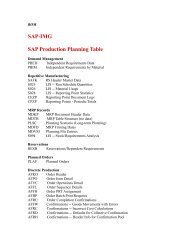Object Oriented ABAP
Object Oriented ABAP
Object Oriented ABAP
Create successful ePaper yourself
Turn your PDF publications into a flip-book with our unique Google optimized e-Paper software.
22. How to use <strong>ABAP</strong> Classes in Process Steps of Business Workflow?<br />
In process steps we can use methods and attributes of <strong>ABAP</strong> classes in the same way as<br />
methods and attributes of Business <strong>Object</strong> Repository (BOR) objects. We can call these<br />
methods in the process context.<br />
Features:<br />
While using the <strong>ABAP</strong> Classes in the Process Steps the methods may contain dialogs, they<br />
can be synchronous or asynchronous; they may appear in the workflow log, and so on.<br />
In general, we can use any method that is implemented as a public method. The method<br />
can be implemented in the class itself, in one of the super classes of the class, or by way of<br />
an interface.<br />
The maximum permitted length for methods that are implemented by way of an interface,<br />
for example IF_WORKFLOW~FIND_BY_LPOR, is 30 characters. If the method name is too<br />
long, we can choose a shorter name for the method by defining an alias. If the method is<br />
implemented in the class or in a super class, the name of the method cannot be longer than<br />
30 characters, so this limitation does not apply.<br />
Parameters:<br />
We can assign values from the workflow container to the method parameters. Conversely,<br />
export parameters can be entered as workflow container values. The following overview<br />
shows how the individual types can be used as parameters:<br />
Simple types (string, integer, and so on)<br />
Data Dictionary types (structures, tables, complex types)<br />
References to objects from the Business <strong>Object</strong> Repository<br />
References to <strong>ABAP</strong> classes (supporting the IF_WORKFLOW interface)<br />
We can transfer method parameters that represent a persistent object (IF_WORKFLOW or<br />
BOR <strong>Object</strong>) in the following ways:<br />
<strong>ABAP</strong> classes (with IF_WORKFLOW interface)<br />
TYPE SIBFLPORB<br />
<strong>Object</strong> is transferred using the persistent display<br />
TYPE REF TO



